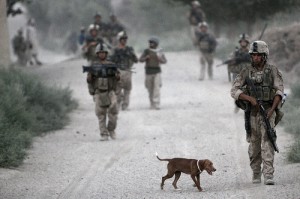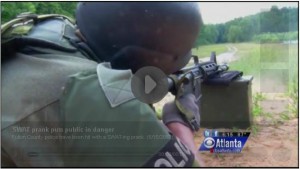Rajiv Chandrasekaran, writing for The Washington Post, excerpts his book, beginning his article with the following indictment.
The day after he arrived in Kabul in June 2009, Gen. Stanley A. McChrystal, then the top U.S. and NATO commander in Afghanistan, gathered his senior officers to discuss the state of the war. They barraged him with PowerPoint slides — the frequency of Taliban attacks and their impact; the number of local security forces; and an evaluation of the Afghan government’s effectiveness in each province. The metrics were grim, the conclusion obvious: The Americans and their NATO allies were losing.
The part of the country that concerned McChrystal most was the city of Kandahar and the eponymous province that encompasses it. Founded by Alexander the Great in 330 B.C., Kandahar city has long been the symbolic homeland of ethnic Pashtuns. In the 1990s, just as every other band of conquerors had done for the past thousand years, the Taliban used it as a springboard from which they captured Kabul and much of the rest of the nation. If the Americans were going to retake Afghanistan, they needed to start with Kandahar.
But the Pentagon had not sent most of the new U.S. forces that had arrived in Afghanistan to Kandahar. The first wave — a Marine brigade comprising more than half of the 17,000 additional troops President Obama authorized in February 2009 — had been dispatched to neighboring Helmand province, which McChrystal and his top advisers considered of far lower strategic significance.
“Can someone tell me why the Marines were sent to Helmand?” the incredulous McChrystal asked his officers.
The answer — not fully known at the time to McChrystal and his officers — would reveal the dysfunction of the U.S. war effort: a reliance on understaffed NATO partners for crucial intelligence, a misjudgment of Helmand’s importance to Afghanistan’s security, and tribal politics within the Pentagon that led the Marines to insist on confining themselves to a far less important patch of desert.
The consequences were profound: By devoting so many troops to Helmand instead of Kandahar, the U.S. military squandered more than a year of the war. Had the initial contingent of Marines been sent to Kandahar, it could have obviated the need for a full 30,000-troop surge later that year, or it could have granted commanders the flexibility to combat insurgent havens in eastern Afghanistan much sooner, allowing them to meet Obama’s eventual withdrawal deadlines without objection.
Instead, U.S. forces will begin heading home this summer with much of the east in disarray and security improvements in Kandahar still tenuous. Helmand is faring considerably better, but the gains there are having only a modest impact on Afghanistan’s overall stability.
Without the diversion into Helmand, U.S. troops could have pushed into more critical areas of the country before a clear majority of Americans concluded that the war was no longer worth fighting.
Analysis & Commentary
This is horse shit. Obama and McChrystal have culpability, and we’ll get to that in a moment. But the tale being spun here makes it sound like a few more sprinkles of magic counterinsurgency pixie dust and the whole thing would have gone much easier. Perhaps unknown to many who didn’t follow the warp and woof of the campaign, this issue about why the U.S. Marines went to the Helmand Province is not a new debate. Neither is the story that McChrystal was presented with the decision to send most of the Marines to Helmand as a fait accompli. Logistical and institutional inertia made it impossible to change things. Or at least, that’s the story.
Rajiv is telling a tall tale, and the issue was much more complicated than he hints. I discussed this almost three years ago, and the same thing is true today that was true when I penned the defense of Marines in the Helmand Province. McChrystal and the Pentagon were under the influence, even control, of the advocates of population-centric counterinsurgency.
Bring stability operations to the population centers, and good governance, goods, services, participation in government on the local level, redress of grievances, and so on, and it will render the outlier Provinces and lower population centers irrelevant, with insurgents unable to topple the central government from those far flung places.
But recall, this is the same Stanley McChrystal that allowed David Rodriguez to micromanage the Marines on their way through Marjah. “Less than six hours before Marines commenced a major helicopter-borne assault in the town of Marja, Rodriguez’s headquarters issued an order requiring that his operations center clear any airstrike that was on a housing compound in the area but not sought in self-defense.”
Killing the enemy wasn’t a priority. Rajiv even says so later in the article, exclaiming “the military’s counterinsurgency strategy was supposed to place troops near civilian population centers to protect residents from insurgents, not chase bad guys in the desert or remote valleys.” But arguing for doing just that, I observed that the insurgents who destabilized Kandahar and other areas of Afghanistan came from Helmand, Kunar, Nuristan and other far flung places where we needed to chase and kill them.
In fact, the larger scale Marine Corps operations in Helmand were predated by intensive fights by the 24th MEU in Garmsir where they killed some 400+ Taliban fighters. The hue and cry of the people at that time had nothing to do with wells, schooling, governance or anything of the sort. “We are grateful for the security. We don’t need your help, just security.” Similar words were spoken at a meeting in Ghazni with the U.S. Ambassador to Afghanistan: ““We don’t want food, we don’t want schools, we want security!” said one woman council member.”

Corporal William Ash, a squad leader from 1st Platoon, Bravo Company, Battalion Landing Team 1st Battalion, 6th Marine Regiment, 24th Marine Expeditionary Unit, NATO International Security Assistance Force (ISAF), along with a stray dog lead a patrol through a city in Helmand Province, Afghanistan. When the platoon moved into the area, they found two stray dogs, and each time the Marines head out on patrol the dogs are right at the Marines’ side.
In fact, I remarked at one point how ironic it was that McChrystal, who was so concerned about inadvertent casualties that his ROE wouldn’t even allow illumination rounds for night time combat, and who wanted separation of the insurgents from the population in order to engage, was so unpersuaded by the Taliban invitation to join them in a fair fight in Now Zad, where they had completely run off the population and were using the place as an R&R haven.
So did the Marines have enough men to engage Kandahar and Helmand at the same time in order to prevent having to play whack-a-mole counterinsurgency? Recall that while I was the only blogger at the time covering and commenting on Now Zad that while the men there were losing legs, arms and their lives, living in hobbit holes two or three Marines to a hole, I could not recall any time in the last four years driving across Camp Lejeune when there were so many barracks being built, so many Marines in the states, and so many units living in multiple different locations on the base because there wasn’t enough housing for them in the same barracks.
Recall that I also said that there were Marines who had finished entire periods of enlistment who, while spending time on wasteful MEUs floating across the seas and stopping in every port to become drunk, had neither been to either Iraq nor Afghanistan in the entire four years.
Yes, there were enough Marines to have pulled this off. A Regimental Combat Team or two could have locked down Kandahar like they did in Fallujah in 2007, conducted census operations, and found and killed the Taliban fighters. Kandahar could have been essentially cleared with enough focus and effort.
But McChrystal’s strategy not only abandoned far flung Provinces to focus on population centers … leaving the roads to the insurgents just like the Russians did … it abandoned the Pech River Valley in Kunar and Nuristan, along with the entire Hindu Kush mountains. Every military strategist now acknowledges that this was an error, and we are back into Nuristan.
But only for a while. After all, we have given a date for withdrawal. With obfuscation like Rajiv’s article, it’s easy to forget that the administration which began its tenure with a commitment to “the good war” saw that commitment evaporate in the face of hard questions. What was an effective campaign slogan soon became a byline, and rather than meet the military needs for a full scale surge, we saw a half-ass surge that gave them only some of what had been requested.
At the same time, an end date was set, with the enemy now knowing just how long it would take to run out the clock. Puerile national security advisers turned Afghanistan into the WTF? war, and men who gave so much in this awful region of the world now see no reason for the loss, and are simply happy to have brought their men home.
There were many mistakes in the campaign: a half-ass surge, a childish national security adviser, McChrystal having surrounded himself with juveniles, overbearing rules of engagement, under-resourcing, strategy that could have been created with a random number generator any given day, poor communication to the American people as to the reasons for the campaign, failure to hold Pakistan accountable for harboring the enemy, loving up on corrupt politicians like Hamid Karzai and his brother Wali Karzai, sending billions of dollars to enlarge and ensure the corruption, and on and on the list goes.
But pointing a finger at the hard work of the U.S. Marines in Now Zad, Musa Qala, Sangin, Garmsir and other places in Helmand isn’t just unfair. It’s scurrilous and dishonest. The administration bears the responsibility for the failure. Campaign slogans aren’t just word games, they are promises to be kept by men in authority and power. The Soldiers and Marines who have perished demand better of our leaders.





